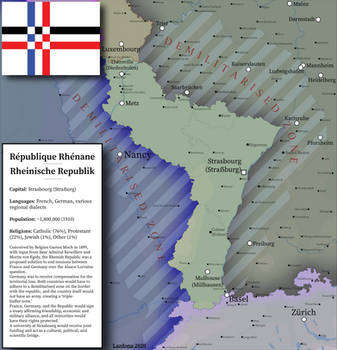Deviation Actions
Description
For the basic context of this detail piece, check out the main map and read through the timeline here: fav.me/d9km3ll
This map provides a somewhat more focused picture of Germany's final borders in 1935, as stipulated by the alternative treaty, following satisfactory fulfillment of all conditions necessary for the League of Nations to lift the final territorial “pinprick” – deferred union with Austria.
Apart from Alsace-Lorraine, the balance of considerations guiding these frontiers draw on extensive pre-1914 documentation of all border regions, covering a range of ethnic, linguistic, and other demographic concentrations (note here that state functionaries dispatched by Berlin to West Prussia, for example, are excluded); transport infrastructure, extractable resources, and heavy industry; as well as natural features such as topography and waterways that provide for boundaries that both better conform to the landscape, and wherever possible, are militarily defensible.
Next up, Poland.
Rather than rehash the timeline, I thought I'd treat everyone to a self-indulgent rant about the thought process behind a revised treaty whose borders grant valuable concessions to the most prominent defeated aggressor in a conflict that had condemned millions to purposeless slaughter.
These frontiers reflect my best effort to systematically identify key considerations necessary for the stable division of national territories. To help ensure that these guiding considerations are of any use, I have attempted to compile all territorial demands put forward in 1919, whether by the Allies, by other neighboring states, or by the Germans themselves, and to judge the broader strategic implications of each demand according to three basic criteria. The first criterion is the political urgency of the demand for establishing a stable postwar order firmly rooted in liberal democracy. The second criterion is the material benefit of the demand to any affected populations. The third criterion is the military defensibility of the demand's resulting borders, given the local terrain. The extent to which a given demand satisfied these three criteria determined its merit as a guiding consideration. In the admittedly frequent instances where no demand meaningfully satisfied all three criteria, I have attempted to devise a solution that does.
By contrast, in the original historical timeline, the Big Three demarcated borders according to a set of considerations that drew only on their own territorial designs, or those advocated by Germany’s least friendly postwar neighbors. The criteria that shaped their guiding considerations were, primarily, a proposal's urgency for advancing each major Allied power’s own national self-interest, and secondarily, the degree to which a given demand could most easily deliver the *perception* of justice, in the sense that populations of concern *to the Allies* had fewer grievances over which to forment economic or even military instability. A military balance of power (in contrast to national self-defense) was the third criterion.
German demands and goals were of little concern in this process, as the Big Three trusted their own appraisal of what constituted an acceptable outcome for the Reich and its people. Yet fear was widespread both among the rank-and-file Allied delegates at the peace conference - and among each Allied power’s general voting public - that baldly punitive measures might lead Germans to embrace a dangerous, possibly revolutionary mass irredentism. Both George and Wilson, for their own reasons and after their own fashions, felt obliged to acknowledge this risk on multiple occasions. Yet however well-acknowledged the risks of provoking German irredentism, calls to minimize this danger were the least likely demands to ever qualify for inclusion in a Big Three consideration set guiding their final demarcation of Germany’s boundaries. Senior delegates in their charge would often airily dismiss the question as a sentimental over-complication, if not a mark of disloyalty to crown or country. Perversely, one such delegate, having just assisted the Big Three in splitting the Reich’s territory in two to make way for the Polish Corridor, even argued that disregarding the risk of German irredentism was perfectly acceptable *because* Germany’s economic might and vast territory made the nation and its people able to bear such a “minor amputation”. The fruits of such arrogance included, among others, such injured collective pride among tens of millions of educated, civilized German citizens that they were primed, once exhausted by economic depression, to find a certain sweet vengeance in Hitler’s brutal message of hatred and total domination.
My assumption, then, is that that the consideration sets guiding the revised treaty’s borders here are more advantageous, in that they allow the occasional demand expressed by Germans to qualify as a key consideration when demarcating borders. As such, demands to mitigate the very real risks of German irredentism, obvious enough in 1919, have been able to function as an important consideration when necessary at certain points in the process. As such, I suspect that the revised treaty should have left the German people less inclined to embrace the barbarism of Nazi rule.
is it on purpose different, because I think the Eger region stretched a bit more into it.
I just wanna help, not meant bad ofc, but I think good criticism is always very helpful.
































